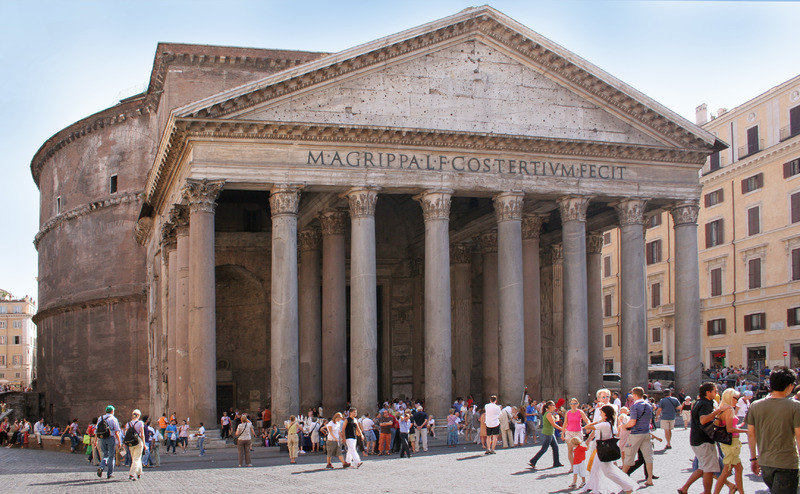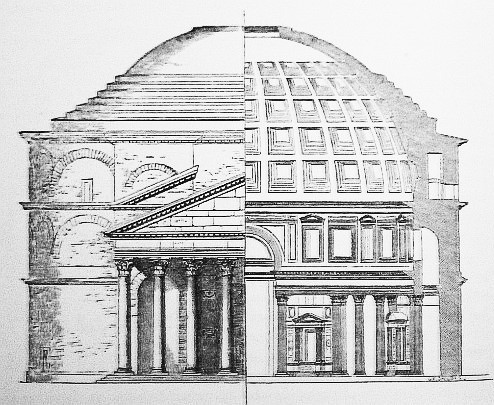Exterior

Front, exterior view of the Pantheon. Shows architecture influenced by traditional Greek temples, including colonnade holding up the triangular pediment.
Porch
At the front of the Pantheon, sixteen, monolithic columns form the monument’s well-known portico. The shafts (cylindrical part of the column) are made of Egyptian granite, while the capitals (decorative top of the column) and bases were carved from white Greek marble. The Corinthian capital gives the structure an intricate, decorative quality that starkly contrasts with the smooth, heavy shaft below.
Interestingly enough, studies showed that the columns’ heights and widths vary from column to column. Research has proved that the difference in measurements were most likely because they outsourced materials and labor from several locations. The columns, which had to be shipped overseas, ended up shorter by 10 feet and had to be accommodated by a lower porch.1 Since the projects were distributed to different constructors, builders expected to accommodate some inconsistencies. For the Pantheon, such adjustments included varying shaft heights and widths.2 After the drum was constructed, the rectangular intermediate block was created to connect the circular part of the structure to the temple-like porch.3 In antiquity, construction involved refinement and compensation, especially when creating a monumental structure like the Pantheon.
Dome
The Pantheon’s drum, is a massive, cylindrical structure that forms the bulk of the monument. Though made of concrete, it is deceivingly light — the thicker sections of the wall accommodate empty, semicircular spaces.4 The drum’s solid appearance conceals its hollow interiors while maintaining its strength. The Romans invented and utilized a system of interlocking brick arches, vaults, and piers to enable the drum’s even weight distribution and support. From the outside, the monument seems dense but allows a hollow interior: this Roman technique can be seen in Trajan’s Column, which accommodates a spiral staircase within its shaft. Some historians have used this parallel to Trajan’s Column as support for the Pantheon’s stronger association with Trajan, rather than Hadrian.5
The dome itself is created by overlapping barrel vaults over the third-story chambers; this technique relates back to the aforementioned octagonal plan of Nero’s palace. The drum and step-rings (the stacked, shallow cylinders at the base of the dome) support around 65 percent of the dome’s weight.6 The dome’s careful weight distribution minimized the amount of its unsupported weight, strengthening and stabilizing the overall structure. The dome is still covered in plaster, but the exterior, which was originally protected with bronze plates, was eventually replaced with lead.7 The only remaining bronze functions as a protective support around the oculus.
1 Mark Jones, "Building on Adversity," in The Pantheon, ed. Marder and Jones, (New York, NY: Cambridge UP), 220.
2 Lothar Haselberger. "The human eye and 3D laser scanning: the Pantheon's facade and its capitals," in Journal of Roman Archaeology, (Rhode Island: Journal of Roman Archaeology, 2015), 54.
3 Jones, The Pantheon, 222.
4 Giangiacomo Martines, "The Conception and Construction of the Drum and Dome," in The Pantheon, ed. Marder and Jones, (New York, NY: Cambridge UP), 106.
5 Ibid.
6 Ibid., 125.
7 Claridge, Rome, 228.
